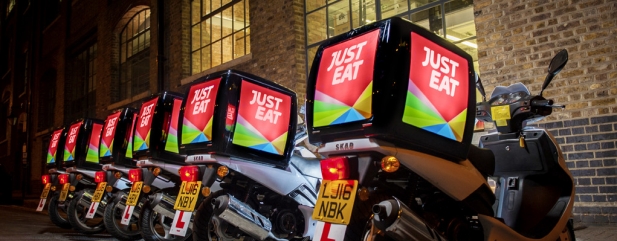Archived article
Please note that tax, investment, pension and ISA rules can change and the information and any views contained in this article may now be inaccurate.
What’s next on the menu for Just Eat?

Investors may not be fully appreciating Just Eat’s (JE.) opportunity to drive revenue beyond simply signing up new restaurants and powering their online ordering system.
Peel Hunt analyst James Lockyer believes the company should also be able to use its data to earn more from restaurants and help them cut costs and push up prices.
He believes investors buying the shares today at 673.95p could make just over 30% profit over the next 12 months, citing an 895p price target.
Getting discounts for customers
The Peel Hunt analyst says Just Eat is quickly becoming a ‘negotiator-in-chief’ for its 71,000 restaurant customers, arranging discounted bulk-buy wholesale sourcing for items such as food, drink, broadband and even motorbike insurance for delivery drivers.
He believes the company’s next step is to capitalise on the billions of pieces of takeaway food preference and order data it already collects each year. Lockyer believes this information could help restaurants to optimise their menus.
Theoretically this could mean dropping some of the least popular items, and potentially reducing costs as there would be less wastage. Restaurants may also then be able to push up their prices for the most popular items.
The analyst claims Just Eat could provide even more sophisticated data services, such as the average price of certain menu items in a geographic area. Another suggestion is using data to work out if a restaurant should think about relocating a branch if the current location is cannibalising sales from another site.
Any income boost should, in theory, mean restaurants would be more than capable of paying Just Eat additional money for its data analysis service. Lockyer believes this value-added service would essentially make the restaurants ‘more sticky’ customers as they would become even more reliant on Just Eat’s services.
The diversified model would not only boost Just Eat’s profitability but could also deter others hoping to bypass the company by developing their own offering.
The share price keeps rising
Shares in Just Eat have shrugged market concerns about slowing growth and doubts whether it will be allowed to buy UK rival, Hungryhouse. They are up 15% so far this year and up 131% over the past five years.
The stock trades on 28.3 times forecast earnings for 2018, which many investors would consider to be a rich rating. Lockyer suggests price to earnings isn’t perhaps the best way to value the business.
‘When you are growing twice as fast as peers, one has to look at multiples adjusted for growth,’ says the analyst. ‘On this basis, Just Eat is 57% cheaper on sales, 47% on EBITDA (earnings before interest, tax, depreciation and amortisation), and 37% on earnings.’ (LMJ)
Important information:
These articles are provided by Shares magazine which is published by AJ Bell Media, a part of AJ Bell. Shares is not written by AJ Bell.
Shares is provided for your general information and use and is not a personal recommendation to invest. It is not intended to be relied upon by you in making or not making any investment decisions. The investments referred to in these articles will not be suitable for all investors. If in doubt please seek appropriate independent financial advice.
Investors acting on the information in these articles do so at their own risk and AJ Bell Media and its staff do not accept liability for losses suffered by investors as a result of their investment decisions.

 magazine
magazine









